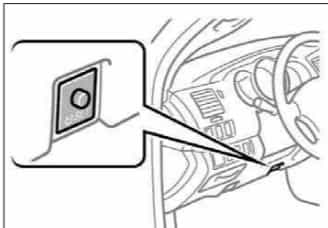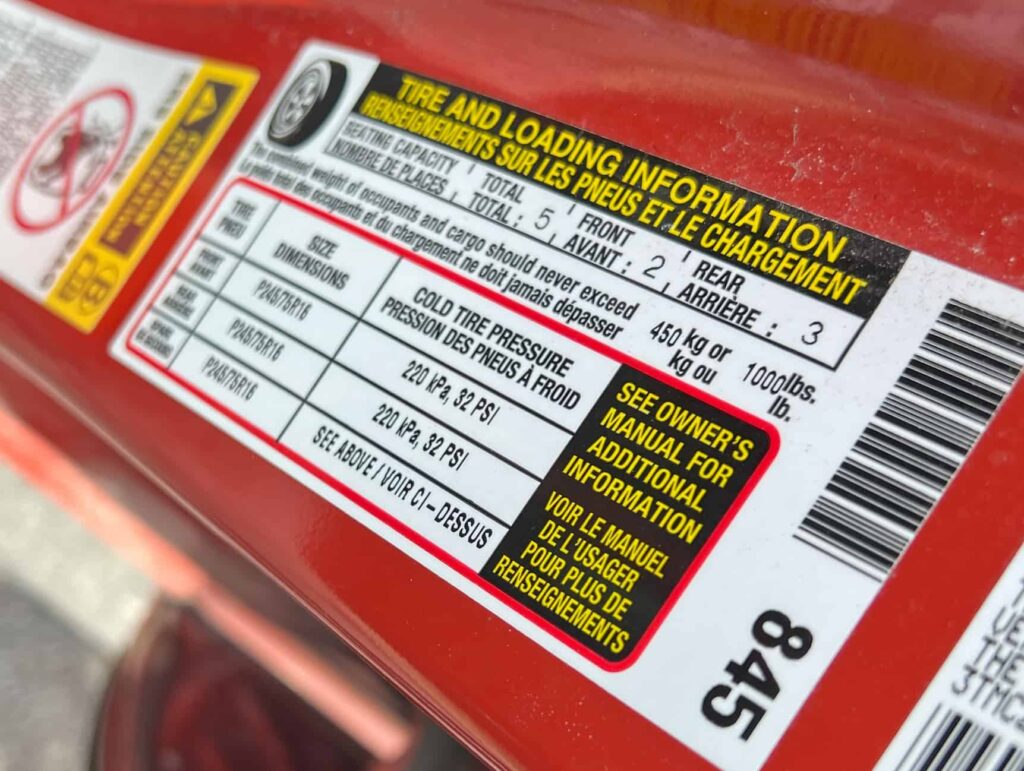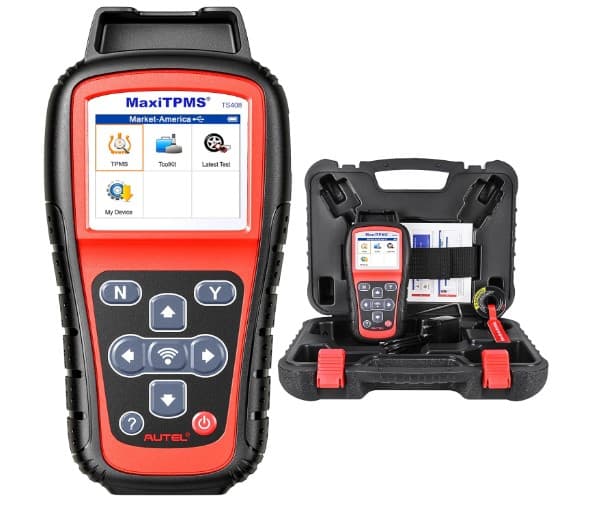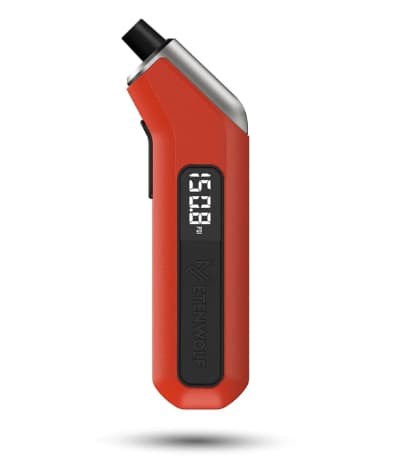STEPS TO RESET TOYOTA TACOMA TIRE PRESSURE MONITORING SYSTEM
2004-2015 TOYOTA TACOMA TPMS RESET
Inflate all 4 Toyota Tacoma air pressure to the recommended pressure levels.
Start the engine.
Hold down the Toyota TPMS reset button underneath the steering wheel. It says “SET” on it.
The low tire pressure warning light will flash on the dashboard 3 times and then turn off.
Release the Toyota TPMS “set” button after the tire pressure light stops flashing.
Drive your Toyota Tacoma for a few minutes at speeds above 24 Mph.
2015-2025 TOYOTA TACOMA TPMS RESET
Check and inflate the air pressure in all 4 tires (check the spare) so they match the Toyota Tacoma recommended pressure values.
Start the engine.
Reach under the steering wheel and hold down the “SET” button. (The Toyota Tacoma TPMS reset button is located next to the hood latch)
While you hold the TPMS reset button, the low tire pressure fault light will flash 3 times on the information display.
After the low tire pressure light stops flashing, let go of the TPMS reset button.
Afterward, drive your Toyota Tacoma for a few minutes at speeds above 24 Mph.
WHAT IF THE TPMS RESET PROCEDURE DID NOT WORK?
If holding down the TPMS reset button did not turn off the tire pressure light, turn the engine and power of the vehicle off and then repeat the TPMS reset process at least one more time. Make sure all the doors and the hood are closed.
WHY DIDN'T THE TOYOTA TPMS RESET PROCEDURE WORK?
There are 3 main causes why the Toyota tire pressure reset process did not work:
The tires are losing or low on air pressure. Double check all the tires air pressure. If any of the tires have lost air pressure since the last time you checked, you have a leak.
One or more tire pressure sensors are low or have run out of battery power. To determine which sensor is low, you will require a TPMS diagnostic tool.
The spare tire has a tire pressure sensor in it and is low on air. If all of the tires have metal valve stems but the spare has a rubber valve stem, it does not have a sensor in it. If all the valve stems are rubber, check the spare tire air pressure to be sure.
TOYOTA TACOMA TPMS EXPLAINED
The Toyota Tacoma’s Tire Pressure Monitoring System (TPMS) is a key feature for safety and efficiency, intricately designed to maintain optimal tire pressure. It consists of four sensors, one in each tire, and a dedicated TPMS receiver module, all integrated with the vehicle’s main computer (ECU or ECM). This system is not just a convenience but a crucial safety element, reflecting the evolution of automotive technology and its focus on ensuring both vehicle longevity and driver safety.
TPMS COMPONENTS AND HOW THEY WORK
TOYOTA TACOMA TIRE PRESSURE SENSORS
Each tire of the Toyota Tacoma has its own tire pressure sensor, housed in a compact plastic casing attached to the valve stem. Inside, there’s a microcontroller, a battery, a pressure transducer, and a combined transmitter and antenna.
Pressure Transducer: This component converts the physical pressure reading into an electrical signal.
Microcontroller: It processes the signal from the pressure transducer and converts it into a data format.
Transmitter and Antenna: These are used to wirelessly send the data to a TPMS receiver module in the Toyota.
Put simply, the microcontroller (a small chip), powered by the battery, measures the tire’s air pressure and the transmitter then sends this information to the vehicle’s TPMS receiver module through radio waves.
TOYOTA TACOMA TPMS RECEIVER MODULE
The TPMS receiver module plays a vital role in the system by gathering air pressure readings from the sensors in each tire and then transmitting this data to the Toyota Tacoma’s main computer, also known as the ECU/BCM.
Receiving Signal from each Tire Sensor: Equipped with an antenna, the TPMS receiver module in the Toyota Tacoma is strategically positioned within the vehicle body, typically under the dashboard or near the center console. As the Toyota is in motion, the sensors in the tires transmit data at set intervals, and the receiver module diligently scans for these signals to ensure continuous monitoring.
Data Processing and Integration: Once a signal is received, the TPMS receiver module processes this data. This involves decoding the signal to extract tire pressure information and identifying which tire the information pertains to.\
TOYOTA TACOMA ECU
In the Toyota Tacoma, the Engine Control Unit (ECU) is integral to processing tire pressure data. It receives this data from the receiver module and compares it against Toyota’s predefined air pressure standards. Should the ECU identify a significant deviation from these recommended pressures in any tire, it activates an alert. This notification typically appears on the vehicle’s dashboard, manifesting as a specific tire pressure readout, a low air pressure light, or a message on the display screen. The ECU is also responsible for displaying the real time tire pressure levels on the Toyota Tacoma information display screen.
TOYOTA TACOMA TIRE SIZE AND AIR PRESSURE
TIRE SIZE | Front Psi/kPa | Rear Psi/kPa |
245/75R16 | 32/220 | 32/220 |
265/60R18 | 29/200 | 29/200 |
265/65R17 | 29/200 | 29/200 |
265/70R16 | 30/207 | 30/207 |
WHAT TO DO FIRST WHEN YOUR TIRE LIGHT COMES ON
As soon as your Toyota Tacoma low tire pressure light turns on, pull over and manually check your tire pressure with a digital tire pressure gauge. Visually inspect each wheel and tire for any abnormalities. If after setting your tire air pressure to the correct Psi the low tire pressure light turns off on its own, this means your tire pressure monitoring system is working properly.
WHY IS THE LOW TIRE PRESSURE LIGHT ON?
Inappropriate Tire Inflation: Both overinflation and underinflation can trigger the light.
Use of Emergency Spare Tire: Driving with the spare tire on.
Battery Issues in TPMS Sensors: Degraded or malfunctioning sensor batteries.
Problems with TPMS Receiver or ECU/BCM: Hardware or software issues in the receiver module or the ECM/ECU.
External Electromagnetic Interference: Interference from devices like radios, cell phones, and alarm systems.
Significant Air Temperature Changes: Shifts of 10 degrees or more affecting tire pressure.
Overloading the Vehicle: Exceeding maximum load capacity or towing limits.
Using Tire Chains: Application of chains can impact pressure readings.
Dark Window Tints: Excessively tinted windows affecting sensor functionality.
Road Temperature Variations: Fluctuations in road surface temperature.
Incorrect Tire Size or Type: Tires not matching Toyota Tacoma’s specifications.
TPMS Sensor or Valve Damage: Occurring during tire replacement or maintenance.
Not Resetting TPMS After Maintenance: Failure to recalibrate the system post-maintenance.
Tire Punctures or Air Leaks: Leading to a loss of pressure.
Physical Tire or Wheel Damage: From road debris or wear and tear.
Faulty or Incorrectly Installed Valve Stems: Impacting tire pressure
WHY COLD TIRES ARE IDEAL FOR ADJUST TOYOTA TACOMA TIRE PRESSURE
For accurate and safe tire pressure adjustments, it’s essential to measure and set the pressure when the tires are cold, as recommended by the manufacturer’s guidelines. Tire pressure fluctuates approximately 1-2 psi for every 10°F change in temperature, often rising by 4-5 psi when tires are warm from driving, causing potentially misleading readings. Cold tires, defined as either before driving or after being stationary for at least 3 hours, provide the most accurate measure.
THE RISK OF OVERINFLATION WITH HOT TIRES
After driving your Toyota Tacoma for just 20 minutes, the air pressure in each tire will naturally rise by about 3-5 Psi from the heat generated between the tire and the road. For example, your Toyota tire pressure light is on, you drive 25 minutes to the local gas station to pump up the tires, you check the air pressure and it reads 31 Psi. Your actual “Cold tire pressure” is probably about 27 Psi. This issue can cause you to accidently overinflate your tires. To summarize, always check and adjust your tire air pressure when the tires are in a cold state.
THE BATTERY LIFE OF YOUR TOYOTA TACOMA TIRE PRESSURE SENSORS
Every tire pressure sensor in the Toyota Tacoma comes with an integrated silver oxide battery that is neither replaceable nor rechargeable. These batteries typically last between 5 to 15 years, or up to about 100,000-150,000 miles. When the battery in a sensor is exhausted, the whole sensor needs to be replaced. To check the battery life of your Toyota Tacoma’s tire pressure sensors, you need a TPMS diagnostic tool.
HOW DO TPMS DIAGNOSTIC TOOLS WORK?
Tire Pressure Monitoring System (TPMS) diagnostic tools are specialized devices designed to communicate with the TPMS sensors. These tools work by sending a radio frequency (RF) signal to the sensor, prompting it to transmit back data such as tire pressure, temperature, battery status, signal strength, and sensor ID. The diagnostic tool receives this data and displays it, allowing technicians to verify the health and functionality of each TPMS sensor. These tools are crucial for diagnosing issues like sensor malfunctions or dead batteries. Some advanced TPMS diagnostic tools can also reprogram sensors, update their software, or initiate a relearning process where the vehicle’s onboard computer recognizes new sensors.
USING TPMS DIAGNOSTIC TOOLS
After checking the analysis the TPMS diagnostic tool provides, any sensor that reports low battery power or incorrect information (such as 0 psi when the tire has 32 psi) means that the tire pressure sensor needs to be replaced with a new one and then programmed to the Toyota Tacoma ECU.
CORRECTING FALSE TIRE PRESSURE ALERTS
If the tire pressure sensors are working properly and the low tire pressure light is still on:
Overinflate each tire by about 10 Psi, fill each tire to about 40 Psi.
Slowly release air from each tire until the pressure is at about 35 Psi.
Follow the Toyota tire pressure system reset procedure.
Drive the Toyota Tacoma for about 10 minutes.
Release the excess air pressure from the tires.
IS IT SAFE TO DRIVE THE TOYOTA TACOMA WITH THE TIRE LIGHT ON?
Driving your Toyota Tacoma with tires that are not properly inflated can be dangerous. It’s crucial to address a tire that is losing air by either repairing or replacing it quickly. Nevertheless, if the low tire pressure alert is triggered by a worn-out sensor battery, it’s still safe to drive as long as the tires are correctly inflated.
HOW MANY MILES CAN YOU DRIVE A TOYOTA TACOMA WITH THE TIRE PRESSURE WARNING ON?
When the low tire pressure light turns on in your Toyota Tacoma, there’s no set distance or time that can be considered safe for driving on. It’s important to stop as soon as possible, visually examine all the tires, and manually check the pressure in each tire with a digital gauge. Depending solely on the tire pressure readings from the Tacoma’s onboard information system is not recommended.
HOW TO HANDLE TIRE PRESSURE SENSORS WHEN CHANGING WHEELS
When replacing the wheels or rims on your Toyota Tacoma, there are a few options available to you:
You can move the existing Toyota Tacoma tire pressure sensors from the current wheels to the new ones.
You can opt for programmable tire pressure sensors (I use Autel programmable tire sensors), install them on the new wheels, and then program them to your Toyota Tacoma’s ECU. This method requires the use of a TPMS programming tool.
When it comes to changing tires on the Toyota Tacoma, follow the standard process for resetting the tire pressure indicator light.
WHY IS THE TIRE LIGHT FLASHING?
When the tire pressure indicator on your Toyota Tacoma flashes, it signifies a disruption in the connection between one or more tire pressure sensors and the vehicle’s ECU. This is known as a TPMS malfunction. This complication typically stems from three primary causes:
The car’s spare tire is in use (if it does not have a TPMS sensor).
The battery in a tire pressure sensor is either exhausted or nearly depleted.
A tire pressure sensor is damaged or not working correctly, resulting in a communication breakdown with the Toyota TPMS system.
HOW SEASONAL TEMPERATURE CHANGES CAN TRIGGER YOUR LOW TIRE PRESSURE ALERT
It is very common for the low tire pressure light to activate when the weather changes. Tire pressure will change by about 1 Psi for every 10°F variation in the surrounding temperature. For example, if the temperature falls by 40°F within a month, the tire pressure in your Toyota Tacoma might decrease from 31 Psi to 27 Psi, causing the low tire pressure indicator to light up.
WHY THE TIRE LIGHT IS ON WHEN THE TIRES SEEM OKAY
Avoid assessing the state of your tires based solely on how they look. It’s crucial to manually verify the air pressure of your Toyota Tacoma tires using a digital tire pressure gauge, particularly if you suspect an issue. When the low tire pressure warning turns off after you’ve inflated the tires, it’s a confirmation that the Tire Pressure Monitoring System (TPMS) is operating correctly.
LOCATING THE EXACT SPOT OF A TIRE LEAK USING SOAP AND WATER
To accurately identify a leak in a tire, adhere to the following procedure:
Inflate the tire in question to a minimum of 40 Psi.
Create a solution of water and soap in a spray bottle.
Generously apply the soapy mixture over the entire tire, paying extra attention to the areas around the bead and valve stem.
Observe for the formation of bubbles and follow them to their source to determine the exact spot of the leak.
Mark the leak location with chalk.
STEPS TO RESET THE TPMS BY DISCONNECTING THE BATTERY
If the low tire pressure indicator on your Toyota Tacoma remains on despite resetting and adjusting the tire pressure system, you might need to disconnect the vehicle’s primary 12-volt battery to clear any TPMS codes from the car’s ECU. Here’s what to do:
Make sure the engine is off and all electrical components (like the radio and lights) are turned off.
Loosen and detach the negative terminal clamp from the battery.
Allow a brief pause before reattaching the terminal and ensuring it is fastened securely.
This method should deactivate the low tire pressure warning. Nevertheless, if the low tire pressure alert on your Toyota Tacoma turns back on while driving, this could signal a problem with one of the tire pressure sensors or a tire that is gradually losing air.
THE RELATIONSHIP BETWEEN TIRE PRESSURE AND FUEL ECONOMY
Maintaining the recommended air pressure in your Toyota Tacoma’s tires is essential for optimizing fuel economy. Underinflated tires increase rolling resistance, requiring the engine to work harder and use more fuel. A 10 psi shortfall can lead to a 2% decrease in fuel efficiency. Although these numbers might seem small, they can significantly accumulate, resulting in higher fuel costs over time.
FAQ
CAN THE TOYOTA TACOMA TPMS BE DISABLED?
No. The tire pressure monitoring system (TPMS) in the Toyota Tacoma is built to remain constantly operational and cannot be deactivated. Should the tire pressure sensors be taken out and replaced with valve stems that lack sensors, the tire pressure indicator will first blink and then remain steadily illuminated. This condition is identified as a malfunction in the Tire Pressure Monitoring System.
IS THE TPMS INDICATOR TRIGGERED BY CHANGES IN ALTITUDE?
No. Driving your Toyota Tacoma to higher altitudes is not likely to trigger the tire pressure indicator. When climbing in elevation, the air pressure inside the tires usually rises. Expect an increase of about 0.5 Psi for every 1,000 feet of ascent.
ARE TIRE PLUGS SAFER THEN TIRE PATCHES?
Having worked as an automotive technician for ten years, I often use tire plugs to repair punctures and have found them to be both safe and effective when used correctly. However, it’s crucial not to use tire plugs on tires with excessively worn treads or on the sidewall. In cases of larger punctures or leaks, it’s better to choose a tire patch or replace the tire entirely.
PRO TIP: Use high quality tire plugs. Cheap tire plugs do not last and should not be used.
CAN TIRE SEALANTS CAUSE HARM TO TIRE PRESSURE SENSORS?
Yes, using tire sealants can damage tire pressure sensors. If you use a sealant for a temporary fix, it’s advisable to visit a local repair shop to have the tire cleaned and the tire pressure sensors inspected to make sure they are still working properly.
ABOUT THE AUTHOR
STEFAN A.
Professional Automotive Technician – I am currently an automotive technician in New Jersey and have worked in private shops as well as dealerships for the past 10 years. When I am not writing articles I am wrenching on race cars and driving radio controlled cars at the track!
Everything in this article is applicable to all Toyota Tacoma models and versions built between 2004-2025.
Please note that this blog post contains Amazon affiliate links. This means that if you make a purchase through one of these links, we at TPMSRESET.COM may earn a small commission at no extra cost to you. We only recommend products that we personally use and believe in. Thank you for supporting us.









